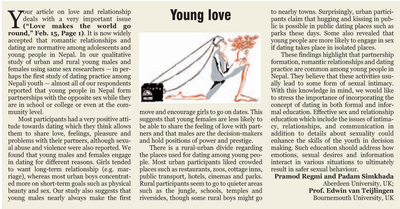Regmi, P., Simkhada, P. and van Teijlingen, E., 2010. Young Love. The Kathmandu Post (17-2-2), 7.
Full text available as:
![Letter to the editor Kathmandu Post [thumbnail of Letter to the editor Kathmandu Post]](https://eprints.bournemouth.ac.uk/12970/1.hassmallThumbnailVersion/letter_Pramod_Kathmandu_Post_Feb_2010.jpg)  Preview |
Image (JPEG) (Letter to the editor Kathmandu Post)
letter_Pramod_Kathmandu_Post_Feb_2010.jpg - Published Version 126kB |
|
Copyright to original material in this document is with the original owner(s). Access to this content through BURO is granted on condition that you use it only for research, scholarly or other non-commercial purposes. If you wish to use it for any other purposes, you must contact BU via BURO@bournemouth.ac.uk. Any third party copyright material in this document remains the property of its respective owner(s). BU grants no licence for further use of that third party material. |
Official URL: http://epaper.ekantipur.com/ktpost/epaperhome.aspx...
Abstract
Your article on love and relationship deals with a very important issue (“Love makes the world go round,” Feb. 15, Page 1).It is now widely accepted that romantic relationships and dating are normative among adolescents and young people in Nepal. In our qualitative study of urban and rural young males and females using same sex researchers — in perhaps the first study of dating practice among Nepali youth — almost all of our respondents reported that young people in Nepal form partnerships with the opposite sex while they are in school or college or even at the community level. Most participants had a very positive attitude towards dating which they think allows them to share love, feelings, pleasure and problems with their partners, although sexual abuse and violence were also reported. We found that young males and females engage in dating for different reasons. Girls tended to want long-term relationship (e.g. marriage), whereas most urban boys concentrated more on short-term goals such as physical beauty and sex. Our study also suggests that young males nearly always make the first move and encourage girls to go on dates. This suggests that young females are less likely to be able to share the feeling of love with partners and that males are the decision-makers and hold positions of power and prestige. There is a rural-urban divide regarding the places used for dating among young people. Most urban participants liked crowded places such as restaurants, zoos, cottage inns, public transport, hotels, cinemas and parks. Rural participants seem to go to quieter areas such as the jungle, schools, temples and riversides, though some rural boys might go to nearby towns. Surprisingly, urban participants claim that hugging and kissing in public is possible in public dating places such as parks these days. Some also revealed that young people are more likely to engage in sex if dating takes place in isolated places. These findings highlight that partnership formation, romantic relationships and dating practice are common among young people in Nepal. They believe that these activities usually lead to some form of sexual intimacy. With this knowledge in mind, we would like to stress the importance of incorporating the concept of dating in both formal and informal education. Effective sex and relationship education which include the issues of intimacy, relationships, and communication in addition to details about sexuality could enhance the skills of the youth in decision making. Such education should address how emotions, sexual desires and information interact in various situations to ultimately result in safer sexual behaviour.
| Item Type: | Article |
|---|---|
| Group: | Faculty of Health & Social Sciences (Until 31/07/2025) |
| ID Code: | 12970 |
| Deposited By: | Prof Edwin van Teijlingen |
| Deposited On: | 19 Feb 2010 17:35 |
| Last Modified: | 14 Mar 2022 13:28 |
Downloads
Downloads per month over past year
| Repository Staff Only - |
 Tools
Tools Tools
Tools